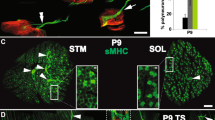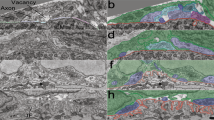Abstract
During normal postnatal maturation, mammalian muscles undergo an orderly process of synapse elimination, whereby each muscle fibre loses all but one of the multiple inputs with which it is endowed at birth1. Experimental perturbations that increase or decrease the overall activity of nerve and/or muscle cause a corresponding increase or decrease in the overall rate of neuromuscular synapse elimination2–7. On other grounds it has been suggested that competition among motor neurons is important in determining which synapses survive and which are eliminated1,8–10. Would a difference in activity among the terminals at the same endplate affect the outcome of the competition and not just its rate? We investigated this issue by blocking activity for four days in a small fraction of the motor neurons innervating the neonatal rabbit soleus muscle. Twitch tensions of motor units were subsequently measured for both the active and inactive populations of neurons to assess whether the inactive neurons had lost fewer or more synapses than is normal. We found that inactive motor neurons have a significant advantage compared to active counterparts in control experiments, a finding opposite to that expected if the neuromuscular junction operated by classical 'Hebbian' rules of competition11.
Similar content being viewed by others
Author information
Authors and Affiliations
Rights and permissions
About this article
Cite this article
Callaway, E., Soha, J. & Essen, D. Competition favouring inactive over active motor neurons during synapse elimination. Nature 328, 422–426 (1987). https://doi.org/10.1038/328422a0
Received:
Accepted:
Issue Date:
DOI: https://doi.org/10.1038/328422a0
- Springer Nature Limited
This article is cited by
-
Terminal Schwann cell and vacant site mediated synapse elimination at developing neuromuscular junctions
Scientific Reports (2019)
-
Neuromuscular synaptogenesis: coordinating partners with multiple functions
Nature Reviews Neuroscience (2014)
-
Genetic evidence that relative synaptic efficacy biases the outcome of synaptic competition
Nature (2003)
-
Long-term synapse loss induced by focal blockade of postsynaptlc receptors
Nature (1994)
-
Simulation of visual cortex development under lid-suture conditions: enhancement of response specificity by a reverse-Hebb rule in the absence of spatially patterned input
Biological Cybernetics (1994)





